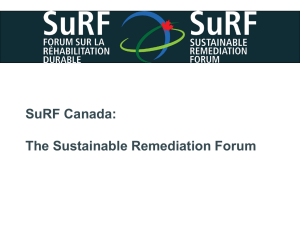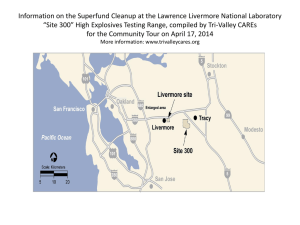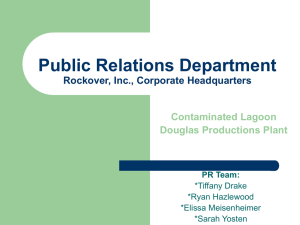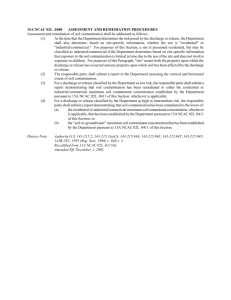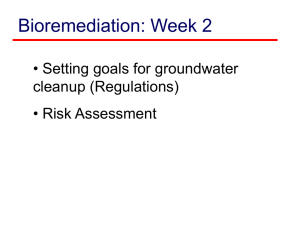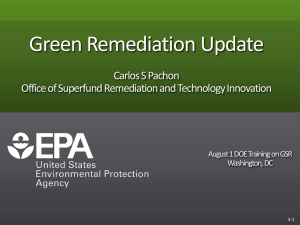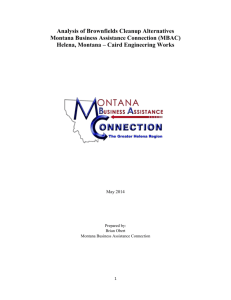See Site Code Description, Table 3
advertisement
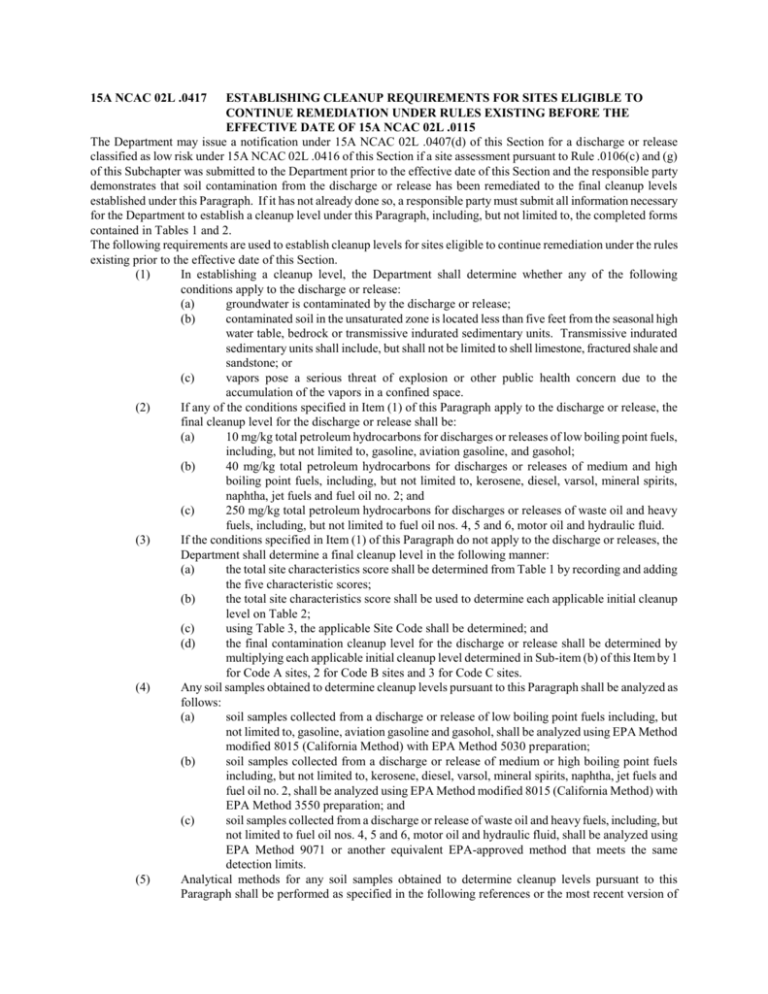
15A NCAC 02L .0417 ESTABLISHING CLEANUP REQUIREMENTS FOR SITES ELIGIBLE TO CONTINUE REMEDIATION UNDER RULES EXISTING BEFORE THE EFFECTIVE DATE OF 15A NCAC 02L .0115 The Department may issue a notification under 15A NCAC 02L .0407(d) of this Section for a discharge or release classified as low risk under 15A NCAC 02L .0416 of this Section if a site assessment pursuant to Rule .0106(c) and (g) of this Subchapter was submitted to the Department prior to the effective date of this Section and the responsible party demonstrates that soil contamination from the discharge or release has been remediated to the final cleanup levels established under this Paragraph. If it has not already done so, a responsible party must submit all information necessary for the Department to establish a cleanup level under this Paragraph, including, but not limited to, the completed forms contained in Tables 1 and 2. The following requirements are used to establish cleanup levels for sites eligible to continue remediation under the rules existing prior to the effective date of this Section. (1) In establishing a cleanup level, the Department shall determine whether any of the following conditions apply to the discharge or release: (a) groundwater is contaminated by the discharge or release; (b) contaminated soil in the unsaturated zone is located less than five feet from the seasonal high water table, bedrock or transmissive indurated sedimentary units. Transmissive indurated sedimentary units shall include, but shall not be limited to shell limestone, fractured shale and sandstone; or (c) vapors pose a serious threat of explosion or other public health concern due to the accumulation of the vapors in a confined space. (2) If any of the conditions specified in Item (1) of this Paragraph apply to the discharge or release, the final cleanup level for the discharge or release shall be: (a) 10 mg/kg total petroleum hydrocarbons for discharges or releases of low boiling point fuels, including, but not limited to, gasoline, aviation gasoline, and gasohol; (b) 40 mg/kg total petroleum hydrocarbons for discharges or releases of medium and high boiling point fuels, including, but not limited to, kerosene, diesel, varsol, mineral spirits, naphtha, jet fuels and fuel oil no. 2; and (c) 250 mg/kg total petroleum hydrocarbons for discharges or releases of waste oil and heavy fuels, including, but not limited to fuel oil nos. 4, 5 and 6, motor oil and hydraulic fluid. (3) If the conditions specified in Item (1) of this Paragraph do not apply to the discharge or releases, the Department shall determine a final cleanup level in the following manner: (a) the total site characteristics score shall be determined from Table 1 by recording and adding the five characteristic scores; (b) the total site characteristics score shall be used to determine each applicable initial cleanup level on Table 2; (c) using Table 3, the applicable Site Code shall be determined; and (d) the final contamination cleanup level for the discharge or release shall be determined by multiplying each applicable initial cleanup level determined in Sub-item (b) of this Item by 1 for Code A sites, 2 for Code B sites and 3 for Code C sites. (4) Any soil samples obtained to determine cleanup levels pursuant to this Paragraph shall be analyzed as follows: (a) soil samples collected from a discharge or release of low boiling point fuels including, but not limited to, gasoline, aviation gasoline and gasohol, shall be analyzed using EPA Method modified 8015 (California Method) with EPA Method 5030 preparation; (b) soil samples collected from a discharge or release of medium or high boiling point fuels including, but not limited to, kerosene, diesel, varsol, mineral spirits, naphtha, jet fuels and fuel oil no. 2, shall be analyzed using EPA Method modified 8015 (California Method) with EPA Method 3550 preparation; and (c) soil samples collected from a discharge or release of waste oil and heavy fuels, including, but not limited to fuel oil nos. 4, 5 and 6, motor oil and hydraulic fluid, shall be analyzed using EPA Method 9071 or another equivalent EPA-approved method that meets the same detection limits. (5) Analytical methods for any soil samples obtained to determine cleanup levels pursuant to this Paragraph shall be performed as specified in the following references or the most recent version of these references: Test Methods for Evaluating Solid Wastes: Physical/Chemical Methods, November 1990, U.S. Environmental Protection Agency Publication number SW-846 and Guidelines for Addressing Fuel Leaks, D.M. Eisenberg and others, 1985, California Regional Water Quality Control Board, San Francisco Bay Region. Table 1 SITE CHARACTERISTICS EVALUATION Characteristic 1) Predominant grain size as classified in accordance with the Unified Soil Classification System or the U.S. Department of Agriculture Soil Classification System Condition Gravel Sand Silt Clay Rating 150 100 50 0 2) Are preferential pathways for contaminant movement such as quartz veins, coarse-grained sediments, fractures and weathered igneous intrusions present in or below the contaminated soil? Present and intersecting seasonal high water table 10 Present but not intersecting seasonal high water table 5 None Present 5-10 feet >10-40 feet >40 feet 0 20 10 0 4) Is the top of bedrock or transmissive indurated sediments located above seasonal high water table? Yes 20 No 0 5) Are artificial conduits present within the zone of contamination? Present and intersecting seasonal high water table 150 Present but not intersecting seasonal high water table 10 Not Present 0 3) Distance between the contaminated/non-contaminated soil interference and the seasonal high water table Total Site Characteristics Score Score ___________ Table 2 CLEANUP LEVEL DETERMINATION Initial Cleanup Level Final Cleanup Level EPA Method 8015/5030 for Low Boiling Point Hydrocarbons such as Gasoline, Aviation Fuels, Gasohol Total Site Characteristics Score Initial Cleanup Level TPH (mg/kg) Select Site Code* >150 <10 Code A Final Cleanup Level 121 - 150 91 - 120 61 - 90 31 - 60 0 - 30 20 40 60 80 100 (Multiply initial cleanup level by 1) 1 x ____ = ___mg/kg Code B (Multiply initial cleanup level by 2) 2 x ____= ____mg/kg Code C (Multiply initial cleanup level by 3) 3 x ____=____mg/kg EPA Method 8015/3550 for Medium and High Boiling Point Hydrocarbons such as Kerosene, Diesel, Varsol, Mineral Spirits, Naptha Total Site Characteristics Score Initial Cleanup Level TPH (mg/kg) Select Site Code* Final Cleanup Level >150 121 - 150 91 - 120 61 - 90 31 - 60 0 - 30 <40 80 160 240 320 400 Code A (Multiply initial cleanup level by 1) 1 x ____ = ___mg/kg Code B (Multiply initial cleanup level by 2) 2 x ____= ____mg/kg Code C (Multiply initial cleanup level by 3) 3 x ____=____mg/kg EPA Method 9071 for Heavy Fuels such as Fuel Oil (#4,#5,#6), Motor Oil, Hydraulic Fluid, Waste Oil Total Site Characteristics Score Initial Cleanup Level TPH (mg/kg) Select Site Code* Final Cleanup Level >150 121 - 150 91 - 120 61 - 90 31 - 60 0 - 30 <250 400 550 700 850 1000 Code A (Multiply initial cleanup level by 1) 1 x ____ = ___mg/kg Code B (Multiply initial cleanup level by 2) 2 x ____= ____mg/kg Code C (Multiply initial cleanup level by 3) 3 x ____=____mg/kg See Site Code Description, Table 3 TPH – Total Petroleum Hydrocarbons mg/kg – milligram per kilogram Table 3 SITE CODE DESCRIPTIONS Code-A Site meets both of the following criteria: 1. Water supply well(s) are within 1500 feet of the release. 2. Public water supply is not available for connecting water supply well users. Code-B Site meets both of the following criteria: 1. Water supply well(s) are within 1500 feet of the release. 2. Public water supply is available for connecting water supply well users, however, water supply wells are still being used. Code-C Site meets the following criterion: 1. No known water supply well(s) are within 1500 feet of the release. History Note: Authority G.S. 143-215.2; 143-215.3(a)(1); 143-215.94A; 143-215.94E; 143-215.94T; 143-215.94V; 143B-282; 1995 (Reg. Sess. 1996) c. 648,s. 1; Recodified from 15A NCAC 02L .0115(s); Amended Eff. December 1, 2005.
